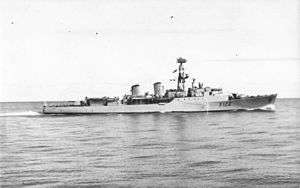HMS Gurkha (F122)
 Gurkha circa. 1964-1966 | |
| History | |
|---|---|
| Name: | HMS Gurkha |
| Builder: | John I. Thornycroft & Company |
| Laid down: | 3 November 1958 |
| Launched: | 11 July 1960 |
| Commissioned: | 13 February 1963 |
| Decommissioned: | 30 March 1984 |
| Identification: | Pennant number F122 |
| Motto: |
|
| Fate: | Sold to Indonesia 1984 |
| History | |
| Name: | KRI Wilhelmus Zakarias Yohannes |
| Acquired: | 1984 |
| Decommissioned: | 1999 |
| Identification: | 332 |
| Status: | Laid up |
| General characteristics | |
| Class and type: | Tribal-class frigate |
| Service record | |
| Operations: | Third Cod War |
HMS Gurkha was a Tribal-class frigate of the Royal Navy. She was named after an ethnic group located in Nepal, and who continue to serve in the British Army.
Royal Navy service
Gurkha was built by John I. Thornycroft & Company, of Woolston, Hampshire,[1] at a cost of £4,865,000[2] She was launched on 11 July 1960 and commissioned on 13 February 1963.[1] In 1965 she was present at Portsmouth Navy Days.[3]
In 1967 she commenced her third commission and served in the Persian Gulf.[4]
In 1975, Gurkha deployed to the West Indies, where the ship performed various duties. In 1976, Gurkha supported Royal Navy efforts against Iceland during the Third Cod War. She sustained superficial damage in May when the patrol ship Óðinn attempted to force the ship towards the British trawler Ross Ramilles, during which Óðinn collided with Gurkha.[5] In that collision Óðinn's port propeller was damaged by Gurkha's starboard stabiliser, forcing her to return to port for repairs.
Gurkha was present at the 1977 Spithead Fleet Review, held in honour of Queen Elizabeth II's Silver Jubilee. At this time she was part of the 1st Frigate Squadron.[6]
Gurkha was reduced to the reserve in 1980, being placed in the Standby Squadron. Although she had been put on the disposal list,[7] Gurkha was removed from the reserve during the Falklands War and prepared for active service.[8] Gurkha remained in home waters, fulfilling duties in the absence of ships that were operating in the South Atlantic. The following year, Gurkha became Gibraltar Guardship.
Indonesian Navy service
After being decommissioned in 1984, Gurkha was sold to Indonesia. She was renamed Wilhelmus Zakarias Yohannes for the national hero Wilhelmus Zakaria Johannes[9] after a radiologist and specialist in X-ray technology. The frigate was withdrawn from service in 1999 and remains laid up at Surabaya Naval Base to await scrapping.
Commanding Officers
| From | To | Captain |
|---|---|---|
| 1965 | 1966 | Commander S Salway RN |
| 1967 | 1968 | Commander R A S Irving RN |
| 1971 | 1972 | Captain D T McKeown RN |
| 1972 | 1975 | Captain V Howard RN |
| 1975 | 1976 | Commander T R Lee RN |
| 1977 | 1977 | Commander D H Barraclough RN |
| 1978 | 1979 | Commander M S Pringle RN |
References
- 1 2 Gardiner, Robert & Chesneau, Roger (1995), p. 518.
- ↑ "Missile Destroyer Cost £15m". The Times (55970): Col B, p. 6. 26 March 1964.
- ↑ Programme, Navy Days Portsmouth, 28th-30th August 1965, p14.
- ↑ http://www.axfordsabode.org.uk/pdf-docs/gurkha01.pdf
- ↑ "Worst night so far in cod war". The Times (59699): Col C, p. 1. 8 May 1976.
- ↑ Official Souvenir Programme, 1977. Silver Jubilee Fleet Review, HMSO
- ↑ Hansard (26 April 1982), hansard.millbanksystems.com. Retrieved 15 March 2012.
- ↑ Hansard (27 May 1982), hansard.millbanksystems.com. Retrieved 15 March 2012.
- ↑ Colledge, J. J. & Warlow, Ben (2010), p. 171
Publications
- Colledge, J. J.; Warlow, Ben (2006) [1969]. Ships of the Royal Navy: The Complete Record of all Fighting Ships of the Royal Navy (Rev. ed.). London: Chatham Publishing. ISBN 978-1-86176-281-8. OCLC 67375475.
- Gardiner, Robert; Chesneau, Roger, eds. (1995). Conway's All The World's Fighting Ships, 1947-1995. London: Conway Maritime Press. ISBN 978-0-8517-7605-7.
External links
| Wikimedia Commons has media related to HMS Gurkha (F122). |